- Health Conditions A-Z
- Health & Wellness
- Nutrition
- Fitness
- Health News
- Ayurveda
- Videos
- Medicine A-Z
- Parenting
- Web Stories
Is There A 'Natural' Ozempic Hiding In Your Gut?
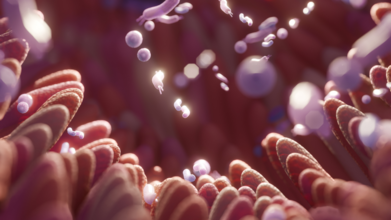
Credits: Canva
Ozempic has been a household name for the last two years. The injectable medication, which was initially designed to treat type 2 diabetes, has now been making the news for its incredible weight loss properties. It functions by doing the same thing as a natural hormone, called GLP-1 (glucagon-like peptide-1), that controls blood sugar and suppresses hunger.
But here's the surprise: your gut might already contain the secret to a similar effect—no needle in sight. A recent study says that some gut bacteria and their products can induce GLP-1 production in manners that mirror what Ozempic does, with implications of a more natural, side effect-free alternative to the drug's effects.
GLP-1 is one of the body's own hunger and blood sugar controllers. It's manufactured by specialized gut cells called enteroendocrine cells (EECs), which detect nutrients and initiate hormonal signals that retard digestion, stabilize blood sugar levels, and make you feel full.
Obese individuals tend to have fewer EECs and reduced GLP-1 activity, making it harder to control appetite. That's one of the reasons why GLP-1 receptor medications like Ozempic work so well—they substitute for what the body isn't currently making in sufficient amounts.
The question has been: how can we make the gut increase GLP-1 levels naturally, without man-made medication?
What Is Natural 'Ozempic' In The Gut?
Scientists at Marshall University in West Virginia think the answer could be affirmative. Their recent study, published in the International Journal of Molecular Sciences, concluded that gut bacteria and their metabolites can persuade the gut to release more EECs—and by association, more GLP-1.
The researchers homed in on tryptophan, an amino acid perhaps most famously associated with turkey dinners. When gut microbes break down tryptophan, they produce a metabolite known as indole. That chemical, they found, behaves like a kind of stimulus for the gut, triggering a cascade that results in the creation of new GLP-1-producing cells.
The major mechanism involved is the aryl hydrocarbon receptor (AhR), a receptor that assists in the control of those cells' response to various molecules. After indole activates AhR, the gut seems to increase its level of EECs, restoring a balance of GLP-1 that can assist in regulating appetite and metabolism.
Thus far, the evidence is from rat tests and cell-cultured "mini-guts" (organoids). Both times, adding tryptophan and indole pushed the gut toward GLP-1 production. But that's still a work in progress to apply to humans.
Obesity and metabolism are mediated by a network of molecular pathways, diet, and lifestyle. What is effective in a rat's gut need not be so in ours. The researchers admit that "the molecular players and signaling pathways involved in the regulation of EEC differentiation could be different in normal and obese conditions.
Nevertheless, the science suggests a thrilling therapy: activating gut microbes, diet, and specific supplementation to push the body to produce its own appetite-controlling hormones.
Is This Ozempic's Natural Equivalent?
Ozempic and other medications in this class are effective, but they come with trade-offs. Nausea, gastrointestinal problems, and worse side effects have occurred. They're costly, too, and, in most nations, difficult to obtain.
A biological route to GLP-1 production—through diet, supplements, or probiotics—may even provide a more secure, less expensive option. Tryptophan is already plentiful in foods such as poultry, eggs, cheese, and some seeds. If scientists can dial in the way that these foods or supplements are utilized to best maximize GLP-1 function, what they create might resemble a "natural Ozempic."
Can You Eat Your Way to the Same Effect As Ozempic?
Although research is in its infancy, history provides a clue that the solution may be nearer than we imagine. Well before semaglutide injections became popular, people across the globe were consuming foods naturally in their diets to support blood sugar balance, hunger regulation, and weight health.
Traditional Diets That Acts Can Mimic Ozempic Weight Loss
The Mediterranean diet—rich in olive oil, fish, legumes, and colorful plants—has long been linked to improved insulin sensitivity and lower risk of type 2 diabetes. Its balance of healthy fats, fiber, and lean proteins naturally slows digestion and helps control appetite.
In Japan, meals centered on rice, vegetables, fermented foods, and small portions have a similar effect. Fermented foods themselves can increase diversity of the gut microbiome, and in turn support GLP-1 activity indirectly.
In Okinawa, purple sweet potatoes and bitter melon have been consumed for hundreds of years. Both are high in compounds that promote gut health and can activate hormones related to GLP-1.
Daily Tweaks You Can Make To Your Plate for Weight Loss
You don't have to transform your diet overnight. Gradual change can coax the gut along the same routes. For instance:
- Having 200–250g of roasted or steamed sweet potato as part of lunch or dinner promotes satiety.
- Incorporating bitter greens like kale or bitter melon into stir-fries could promote gut peptides associated with GLP-1.
- Turmeric incorporated into soups or teas provides an anti-inflammatory kick that promotes general gut health.
- No diet can exactly mimic Ozempic, but these food choices can tune your gut microbiome to the body's built-in appetite controls.
The Marshall University study contributes to a large and expanding area of research that investigates how the gut and its microbes affect obesity and metabolism. What comes next will be required to try these findings in human subjects, determine the ideal dose of tryptophan or indole, and establish safety in various populations.
6 Scary Symptoms ER Doctors Say You Should Never Brush Off

Credits: Canva
We have all been there, done that. Reaching out to Google every time we face slight discomfort sneezing, convinced that we have some serious disease. While not every ache or tickle means an emergency, some symptoms really do need urgent attention. According to ER doctors, there are a handful of red flags you should never brush off.
Here are six warning signs you should pay attention to immediately.
1. Chest Pain That Feels Super Heavy
We have all had heartburn after a cheesy pizza, but chest pain is not something to gamble with. Reports say crushing, pressure-like chest pain that radiates to your arm, jaw, or back is a huge red flag for a heart attack. Sometimes it comes with sweating, shortness of breath, or nausea. Even if you are young and otherwise healthy, do not assume it is just gas or stress. When in doubt, get checked out; it is always better to be told it is heartburn than to ignore a heart attack.
2. The Worst Headache of Your Life
Sure, headaches are common, but if you suddenly feel like someone is hammering your skull with no mercy, do not tough it out. According to the reports, a sudden, severe headache, especially if it is different from your usual migraines, could signal a brain aneurysm, bleeding, or other neurological emergency. Pair that with vision changes, weakness, or slurred speech, and you should be calling for help immediately.
3. Unexplained Shortness of Breath
Running up the stairs and wheezing like a deflating balloon is one thing. But struggling to breathe at rest or without any exertion? That is a whole different story. Experts say unexplained shortness of breath could point to conditions like blood clots in the lungs, asthma attacks, pneumonia, or even heart problems. If your chest feels tight, you are gasping for air, or your lips are turning blue, it is not something to “walk off”.
4. Sudden Weakness or Numbness in One Side of the Body
If you are holding something, and suddenly it slips right out of your hand because your arm has no feeling. Or half your face feels like it is melting. These are classic stroke symptoms, and ER doctors stress that time is everything. The quicker you get treatment, the higher the chances of recovery. Remember the acronym FAST: Face drooping, Arm weakness, Speech difficulty, Time to call emergency services. Do not wait it out hoping it will pass.
5. Uncontrolled Bleeding
A paper cut? No big deal. A deep cut that refuses to stop bleeding after 10 minutes of firm pressure? That is a medical emergency. According to the reports, that uncontrolled bleeding can mean a damaged artery or an underlying clotting disorder. If you are soaking through bandages or the blood will not stop, it is not something to ignore. Plus, losing too much blood too quickly can lead to shock and nobody wants to faint in their bathroom.
6. Severe Abdominal Pain That Comes Out of Nowhere
Stomach aches are often brushed off as bad food choices. But if you suddenly develop intense abdominal pain that does not go away, reports suggest it could be something much more serious, like appendicitis, gallstones, a perforated ulcer, or even an intestinal blockage. The kind of pain where you cannot stand up straight or move without wincing is not the “sleep it off” kind. Trust your gut, literally, and get checked.
Listen to Your Body’s Alarm Bells
Not every symptom is an emergency, but when your body loses it, it is trying to tell you something. ER doctors agree that ignoring these signs can lead to complications that are far harder to treat later.Which Ticks Are Living Around You?
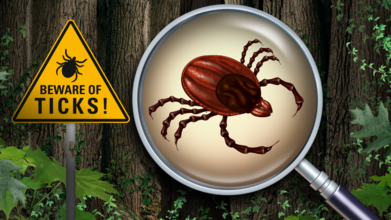
Credits: Canva
As the temperature rises, the rise in tick-borne disease are also being reported. When you think about ticks, you probably think about Lyme disease or the general unease of finding one clinging to your skin.
However here’s an important fact: just because a certain tick species is found in your area doesn’t automatically mean it spreads a specific disease there. Disease transmission depends on several factors, from local ecology to host availability, not simply the presence of ticks.
Still, understanding which ticks are in your region helps you stay alert to potential health risks.
Below is a guide to the major tick species in the United States, what they look like, where they’re found, and the diseases they may carry.
American Dog Tick (Dermacentor variabilis, D. similis)
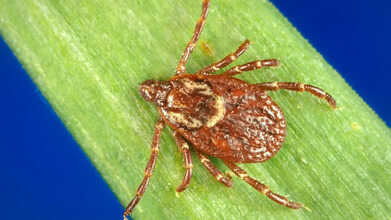
Where found:
As per the Centers for Disease Control and Prevention (CDC), the American dog tick is common east of the Rocky Mountains and in some western pockets. A related species, D. similis, lives west of the Rockies.
What it transmits:
These ticks can spread tularemia and Rocky Mountain spotted fever (RMSF).
READ: First Rocky Mountain Spotted Fever Case Confirmed In Quebec
What to know:
Spring and summer are peak seasons for bites, with adult females being the ones most likely to latch onto humans.
Asian Longhorned Tick (Haemaphysalis longicornis)

Where found:
CDC notes that it was first detected in the U.S. in 2017. This invasive species has spread quickly. As of 2024, it has been reported in at least 19 states, including New York, Virginia, North Carolina, and Kentucky.
What it transmits:
In Asia, these ticks are known to spread pathogens that can make humans and animals seriously ill. In the U.S., their disease-spreading potential is still being studied. While they are less likely to bite humans compared with native ticks, they can carry bacteria that cause Rocky Mountain spotted fever, though this hasn’t been found naturally in U.S. populations yet.
What to know:
These ticks reproduce without mating, meaning a single female can produce thousands of offspring. They’ve been found on pets, livestock, wildlife, and even people, often appearing in large numbers in grassy or shrubby areas.
Blacklegged Tick (Ixodes scapularis)
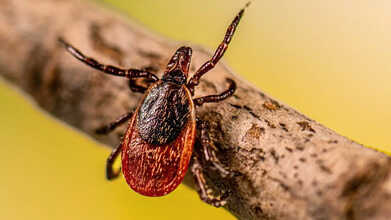
Where found:
CDC notes that this is common across the eastern United States.
READ: Justin Timberlake Reveals Lyme Disease Diagnosis: Here’s What That Means For His Health
What it transmits:
This tick is one of the most medically important in the U.S., spreading multiple diseases, including:
- Lyme disease (Borrelia burgdorferi and B. mayonii)
- Anaplasmosis (Anaplasma phagocytophilum)
- Babesiosis (Babesia microti)
- Ehrlichiosis (Ehrlichia muris eauclairensis)
- Powassan virus disease
What to know:
The risk of bites is highest in spring, summer, and fall, but adults can be active anytime winter temperatures rise above freezing. Nymphs and adult females are the main culprits when it comes to human bites.
Brown Dog Tick (Rhipicephalus sanguineus)
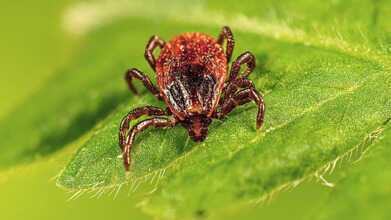
Where found:
It is truly a global traveler, this tick is found worldwide and throughout the U.S.
What it transmits:
In certain parts of the U.S., especially the Southwest and along the U.S.-Mexico border, it can spread Rocky Mountain spotted fever.
What to know:
Dogs are the preferred hosts at every stage of their life cycle, but they can also bite humans. Because of their close association with dogs, they often infest kennels, homes, and even veterinary clinics.
Gulf Coast Tick (Amblyomma maculatum)

Where found:
Primarily in the southeastern U.S., with isolated populations in other regions such as the Midwest and Southwest.
What it transmits:
The main disease linked to this tick is Rickettsia parkeri rickettsiosis, a type of spotted fever.
What to know:
Adults are most often involved in transmitting pathogens to humans.
Lone Star Tick (Amblyomma americanum)

Where found:
This aggressive biter is found widely in the Northeast, South, and Midwest.
What it transmits:
Lone star ticks are linked to several diseases and unusual health effects, including:
- Human ehrlichiosis (Ehrlichia chaffeensis and E. ewingii)
- Tularemia
- Bourbon virus
- Heartland virus
- Alpha-gal syndrome (a surprising tick-related allergy to red meat)
- A rash sometimes called STARI (Southern Tick-Associated Rash Illness)
What to know:
Adult females can be recognized by a single white dot, or “lone star”, on their back. Their bites can cause skin irritation even without infection. Nymphs and females are most likely to bite humans.
Rocky Mountain Wood Tick (Dermacentor andersoni)
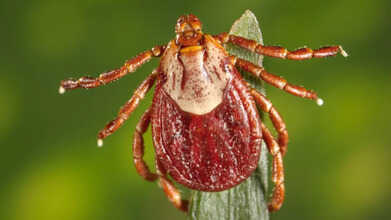
Where found:
Lives in the Rocky Mountain states and parts of southwestern Canada, mostly at elevations between 4,000 and 10,500 feet.
What it transmits:
Known carriers of Rocky Mountain spotted fever, Colorado tick fever, and tularemia.
What to know:
Adult ticks are the primary stage that transmit diseases to people.
Western Blacklegged Tick (Ixodes pacificus)
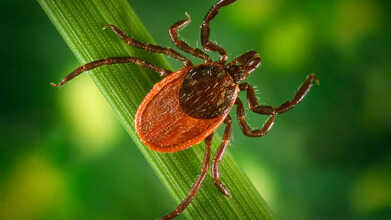
Where found:
It is found along the Pacific Coast, especially in northern California.
READ: Family Shares How A Lyme Disease Misdiagnosis Cost Their Son's Childhood
What it transmits:
This species can spread:
- Lyme disease (Borrelia burgdorferi)
- Anaplasmosis (Anaplasma phagocytophilum)
- Hard tick relapsing fever (Borrelia miyamotoi)
READ MORE: Lyme Disease In US: How Worried Should You Be Of Ticks?
What to know:
Although all stages can bite humans, nymphs and adult females are most frequently reported on people.
Staying Tick-Smart
While different ticks pose different risks, the best prevention steps remain the same:
- Use insect repellent containing DEET, picaridin, or permethrin-treated clothing.
- Wear long sleeves and pants in grassy or wooded areas.
- Perform regular tick checks after outdoor activities.
- Check your pets, too, dogs and cats often bring ticks indoors.
Photos of ticks taken from CDC Website
Neurologist Shares How Using Your Non-Dominant Hand For Daily Simple Activities Can Boost Brain Health

Credits: Canva
When was the last time you tried brushing your teeth with the “wrong” hand and ended up with toothpaste on your nose? Or fumbled with your fork as though you had suddenly forgotten how to eat? As it turns out, those awkward, clumsy attempts may actually be doing your brain a massive favour.
Dr Sudhir Kumar, neurologist, explains: “Using your non-dominant hand for daily activities like brushing your teeth, eating, or opening doors can challenge your brain, encourage new neural connections, and may improve cognitive flexibility over time.”
Using Your Weaker Hand Can Boost Brain Health
You have probably heard that your brain is like a muscle, but have you ever thought about putting it through a workout that does not involve solving puzzles? According to Dr Kumar, “Just like muscles, your brain gets stronger with exercise. Switching hands forces your brain to adapt, stimulating regions that are usually less active.”
That means the slip-ups and slowed-down movements are not failures but signals that your brain is firing up areas it does not usually depend on.
Also Read: Does How You Eat Avocado Affect Its Weight-Loss Benefits?
How to practise it
The best thing about this brain exercise is that you do not need different tools or complicated routines. In fact, the things you do every single day are the perfect training ground. Dr Kumar suggests a few easy ways to get started:
1. “Eat or cook with your opposite hand.”
2. “Use it to operate your phone.”
3. “Write a short note.”
4. “Use it to brush teeth, comb your hair or shave.”
5. “Try simple percussion (e.g., drumming) or piano melodies with the non-dominant hand taking the lead.”
Small switches, big rewards
Scientists often talk about neuroplasticity, which is the brain’s ability to rewire itself. While big life changes and new learning experiences are known to boost this, tiny everyday tweaks, like stirring your tea with your left hand if you are right-handed, also count. Over time, these switches may improve focus, problem-solving skills, and adaptability.
Plus, there is something oddly satisfying about realising you have mastered a task you once struggled with. Writing a little something with your left hand may look tough at first, but give it a week and you will notice surprising progress.
Also Read: Life After Chikungunya: Top Tips On Managing Joint Pain and Regaining Mobility
Of course, do not expect your non-dominant hand to suddenly become proficient at everything you do. At first, the tasks might feel frustrating, and your movements clumsy. But that awkwardness is precisely the point; it is your brain stretching itself in new directions. Training your brain with these small hand switches works on the same principle: deliberate struggle leads to growth.
A playful way to future-proof your brain
Brain health often feels like a heavy topic reserved for discussions about memory loss or ageing, but adding a dose of play makes it a whole lot lighter. Using your non-dominant hand is basically an easy game you can play with yourself, without apps, subscriptions, or brain-training gadgets.
© 2024 Bennett, Coleman & Company Limited

